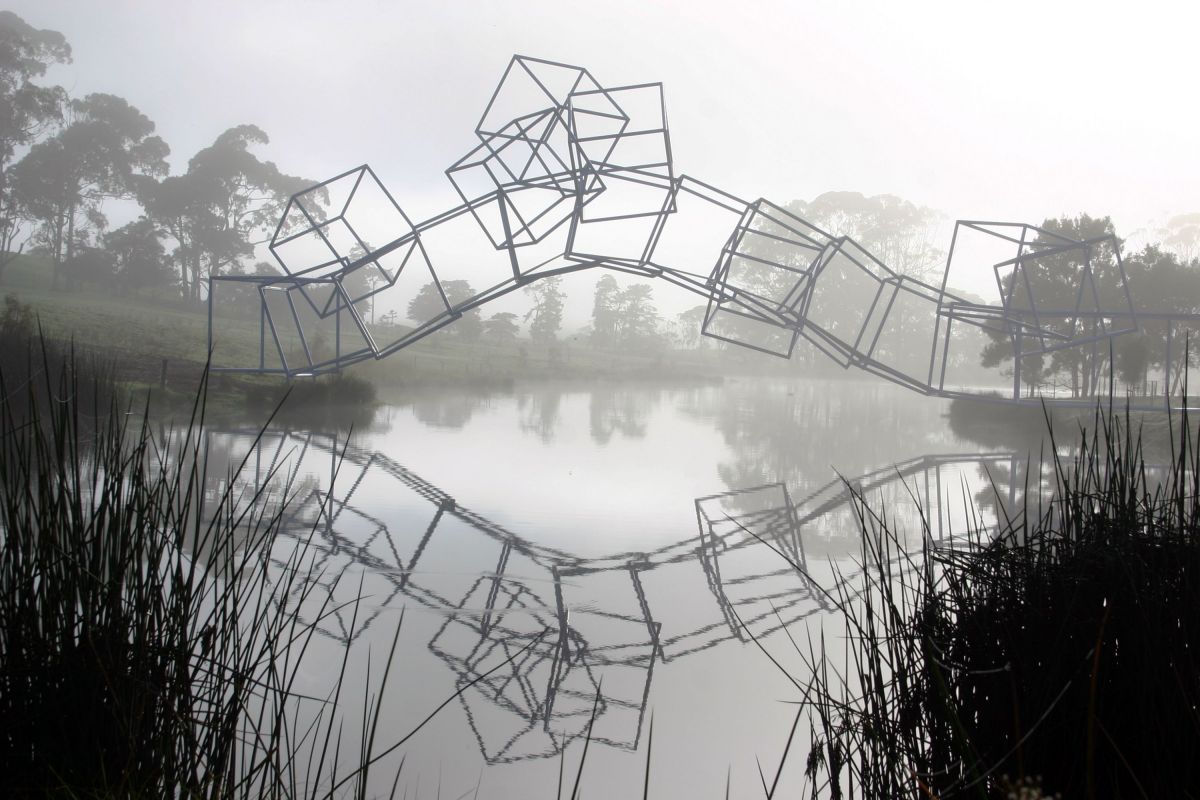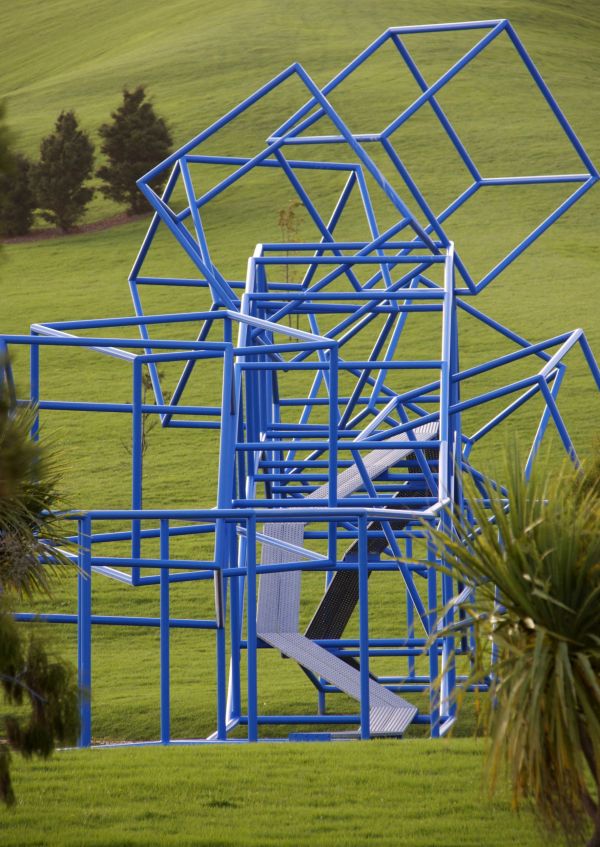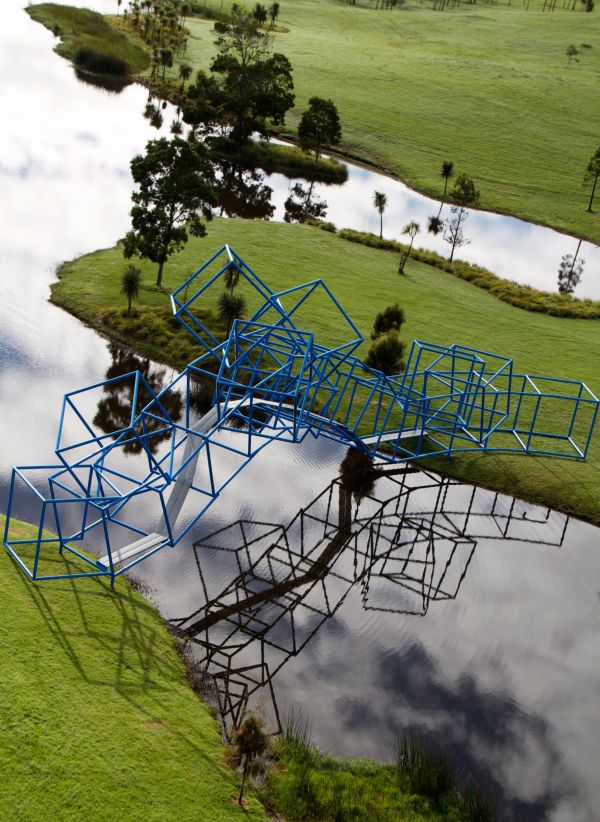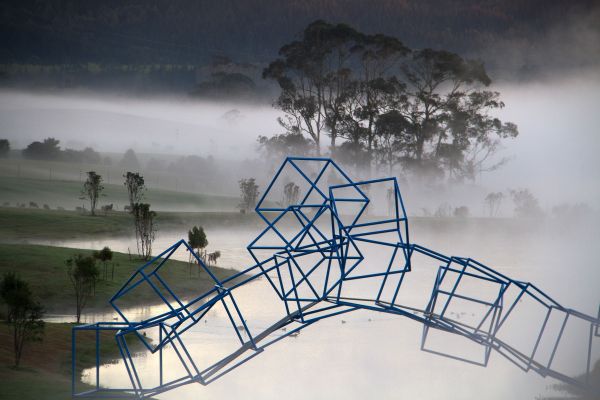The Mermaid
2000. Auckland, New Zealand
Unlike the Netherlands, where the artist has to go with his or her art model to the commissioner, Alan Gibbs came from New Zealand to Amsterdam to see for himself what work of art I had designed.
This approach I have always appreciated. For weeks and weeks I had been sketching and modelling a poetic bridge which could have never ever been built in Holland. Why not? Because poetry cannot by bound be rules and regulations.
Alan proved to be enthusiastic: “The model stood for a year on the mantlepiece in my bedroom and slowly and surely it grew on me. I am fond of the the lyrics of this sculpture. The bridge consists of about 20 cubes, but they jump in every which way. Only a woman can invent something so irrational. It is one of my favourite works.” This made me unbelievably happy. Then and there I dared to ask a favour: “Would you create a lake for me?” He was surprised that somebody from the Netherlands, a country with so much water, wanted to create a lake. But without batting an eyelid he asked: “How large do you want it?” “Well, 250 x 50 meters”, were the first numbers which crossed my mind. All of a sudden I saw an opportunity to create the sculpture with wet feet instead of dry feet in the grass. And so the Mermaid was born. As a good turn deserves another, I gave him my poem about the Mermaid.
The Mermaid
Alone we are born
Alone we die
Let us set our eyes
on our newborn daughters
They rise easily, tender
strange and powerful
They are human
they are bridges
they are the butterflies
in the wind of our new lives.
This to Alan’s great surprise. At the time, I did not know that his Keystone Trust, which manages this estate, consists of his three loving daughters. So this poem struck a chord.
Abstractions continue to be intriguing, are fascinating through their size and carefully chosen lines. The Chinese philosopher Confucius wanted to organize everything. Abstract art organizes itself in a certain way by using a lot of suspense. These virtually classical huge works of art are timeless. The Mermaid bridge has to be an absolute sculpture, which can set an example for architects and engineers. Calatrava’s bridges are works of art, but are functional as well. My Mermaid bridge is merely art. This bridge is the very best example of my work: Jewellery is a sculpture for the body and sculptures are jewellery for the landscape.
During the production process I flew to New Zealand every two months for the accompaniment and motivation of the builders of this difficult work. My bond with the builders became strong and I almost buried them under various little Dutch windmills, wooden clogs and other tourist knickknacks.
With the enormous support by constructor Peter Boardman (who engineers all sculptures on the Farm) we reached a consensus with respect to the corner connection and attachments for this quite tricky structure. At the beginning of the production I had to reject all the tubes originating from Australia as the corner points did not have well cut corners at the tube ends whereby internal welds could not be done and the welds, as a result, remained visible like thick caterpillars on the outside. James Ross, Alan Gibbs’ adviser at the time, came to my rescue in this matter.
In two parts the sculpture was to be flown from the factory near Auckland to the final building site on the Farm. For all persons involved I had bought fresh black tulips wrapped in plastic which were confiscated immediately by customs as their import was not permitted. Near the factory Alan’s helicopter was ready for departure, as well as the Russian helicopter of a sturdy Russian pilot who was going to transport my work. I told him that it would be advisable to take the lightest part of the bridge (4,500kg) first and to hang a bag of water underneath to counteract torsion. I could see him think: What does the blonde know about this? Of course (?), the pilot took the heaviest piece (5,500 kg) first. The helicopter started to twist, landed close to a farm, where curious cows and bulls, including the owner, came running. “What is this?” – The pilot answered: “Can’t you see? This is a bridge!” In the end everything was brought to the building site on the Farm. There, cranes were ready to do their work, the bridge parts were welded together on site and were positioned between the two anchoring points with loving care. Afterwards the Mermaid received its coating in the colour Marijke-blue.
This sculpture bridge is the culmination of my cube-skeleton series which range from miniature to monumental. The bridge consists of 22 cubes, each measuring 3 x 3 x 3 meters of welded round steel tubes in an exuberant shape. The transparent walkway winds itself like a capricious seducer between the cubes without taking the slightest notice of strict safety regulations for the visitors of the bridge. This makes traversing the bridge a thrilling adventure.
The Mermaid’s inauguration was magnificent. Both of the lakes, created for this purpose, for this occasion received a colour treatment with environmentally friendly intense blue pigments. I am delighted to have been given the opportunity to build such a huge sculpture on a private estate where everything is maintained optimally.
[fram] “People fell off it, indeed”, Alan Gibbs laughs. “Among which famous artists. But that’s exactly the fun of it.” When Kenneth Snelson, who has been creating tensegrity sculptures (an abbreviation of tension and structural integrity) for 40 years all over the world – against all advice – wanted to cross the lake via my Mermaid bridge, he fell, in full view of a group of visitors, off the narrow bridge deck into the water. Hopefully The Mermaid will inspire artists, architects, engineers to explore new avenues rather than stay on the traditional courses, so that the landscape is vitalized by pleasant bridgings. Einstein said: “Logic will get you from A to B. Imagination will take you everywhere.” In all our travelling, be it by car, train or plane, it would be wonderful, to get the opportunity of perceiving and experiencing beautiful ‘gems’.







